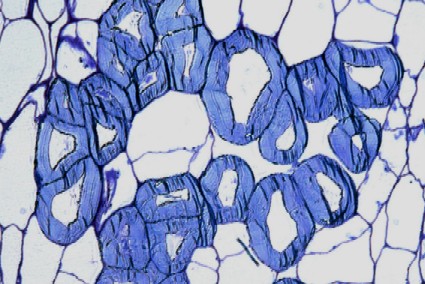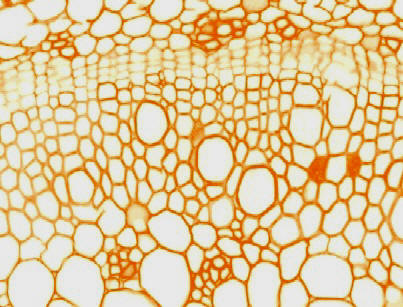Plant cell walls
An introduction
Plants construct dynamic, modifiable & robust materials at their cell surfaces. These cell walls are remarkable materials and they are responsible for many of the differences between plant and animal cells and also dictate the distinctive modes of plant cell development. Plant cell walls generally retain a physical integrity throughout cell life & in several cases, dependent on cell type, a functional role after cell death. Cell walls are constructed from sets of diverse & complex polymers many of which are polysaccharides/glycans. Microfibrils of aggregated cellulose molecules form the fibrous component of cell walls & these are integrated with complex sets of more soluble polysaccharides known as hemicelluloses & pectins - or matrix glycans. Cell wall polymers are capable of varied interactions & interconnections that maintain cell wall integrity & properties such as resistance to tensile & compressive forces, flexibility & porosity. Thin extendable primary cell walls & thicker, tougher non-extendable secondary cell walls (seen in certain cell types) are clear from anatomical sections. Cell walls are highly dynamic in molecular terms & subject to modifications throughout growth & development. They are best regarded as physiologically active compartments of plant cells.

Why study plant cell walls?
The construction & retention of cell walls is a distinctive feature of plants & cell walls have considerable impact on plant growth, development & behaviour. So for many studies of plant biology we need to know about the structures & functions of cell walls. Cell walls constrain cell expansion & thus regulate plant growth, keep cells adhered together maintaining the cohesion of plant bodies & provide the organ robustness to resist gravity, wind & rain along with the mechanical properties to allow root growth through compacted soils. Cell walls molecules are also involved in aspects of cell & organ development as well as defence responses. It could be argued that little makes sense in plant biology without a consideration of cell walls.
Cell walls are also of more direct concern to human activity in that they are of great economic importance not least in in their contributions to the growth and properties of the crops of the world. Cell wall properties are of direct importance for the texture of foods. For example, an apple can be crunchy & juicy or has a dry mealy texture depending on whether its cell walls rupture or separate during eating. Fibre cells with thick tough secondary cell walls provide timber & textiles such as cotton & linen. In addition, cell wall components have useful properties for the manufacture of paper, foods, confectionary & pharmaceuticals. Lastly, but not least, cell walls form the bulk of the biomass of plants and the turnover of these materials is a major aspect of the carbon turnover on the earth's surface. Current searches for environmentally benign fuels brings a focus to the study of cell walls & the optimization of their enzymatic degradation to produce bioethanol or combustion for direct energy release.

Challenges for plant cell wall biology
Current major questions of plant cell wall biology concern how the matrix glycans (including pectins, xyloglucans, heteroxylans and heteromannans) are synthesized & transported from Golgi membranes to the plasma membrane & assembled together with cellulose microfibrils being synthesized directly at the membrane into diverse functional composites.
What properties do individual matrix glycans contribute to the assembly or functional processes of cell walls? What are the dynamics and functions of inter-linkages between cell wall matrix glycans? How do primary cell walls function to constrain & allow cell expansion in terms of both extent & direction? How are wall structures & functions integrated with the plasma membrane & the cytoskeleton?
How do cell wall & middle lamellae polymers maintain cell adhesion & tissue & organ cohesion & at the same time allow both coordinated organ expansion and maintenance of appropriate organ mechanics?
Other questions concern the diversity of cell wall polymers across the plant & algal kingdoms. Do all land plants have broadly the same sets of cell walls polymers? How do structural variants within a polymer class relate to cell functions & plant diversity?
Monoclonal antibodies and recombinant carbohydrate-binding modules are effective molecular probes to detect the structural elements of cell wall polysaccharides & are useful to obtain high level resolution imaging of cell wall microstructures. The detailed mapping of polymers in cell walls has lagged behind structural analyses of cell wall polymers and the current ongoing identification of genes that build & modify the complex polysaccharide structures. It is this gap that we are attempting to address with our sets of cell wall molecular probes. See Generating probes for cell wall polymers
